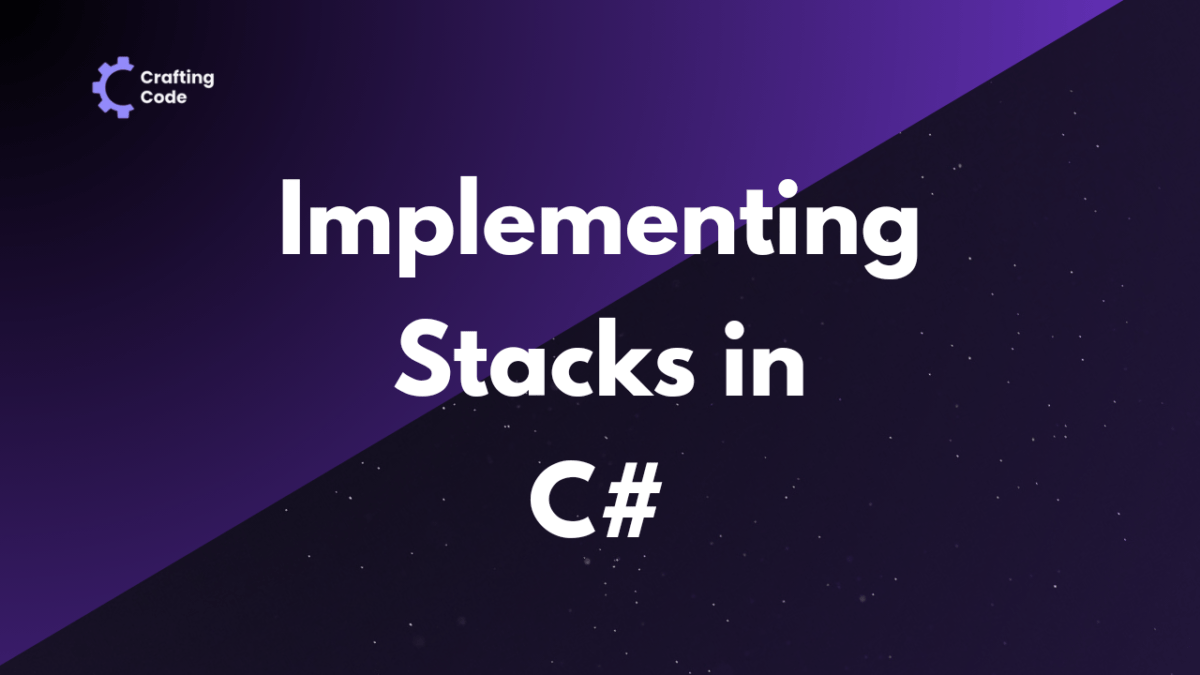To implement stack in C#, you can choose between arrays or linked lists. For array-based implementation, define a class with methods like Push(), Pop(), and Peek()to add, remove, and view elements respectively. Linked list implementation involves defining a class with nodes and similar methods, but with nodes linked together. Both approaches facilitate efficient stack operations.

What is Stack in C#?
A stack is a linear data structure that follows the Last In, First Out (LIFO) principle. It operates like a collection of elements arranged in a specific order, where elements can only be added or removed from the top. This structure allows for efficient insertion and deletion operations, making stacks a fundamental concept in algorithm design and problem-solving.
The LIFO principle governs the behavior of stacks, dictating that the last element inserted into the stack is the first one to be removed. This means that elements are added to the top of the stack and removed from the same position, resembling the behavior of a physical stack where items are placed on top of each other. The LIFO property simplifies the implementation of stacks and facilitates their use in various applications, including function calls, expression evaluation, and backtracking algorithms.
Basic Operations of Stacks
Push() operation
- Explanation of Push Operation: The push operation is used to add an element to the top of the stack. When performing a push operation, the new element is inserted onto the stack, becoming the new top element. This operation increases the size of the stack by one.
- Implementation in C#:
public void Push(int item)
{
// Add the item to the top of the stack
stackArray[++top] = item;
}
Explanation of code:
++top: This pre-increment operation increments the value of the top variable by one before accessing the stackArray. It ensures that the new item is placed at the next available position in the stack, effectively adding it to the top.
Pop() operation
- Explanation of Pop Operation: The pop operation removes and returns the top element from the stack. In the provided C# implementation, the Pop method checks if the stack is empty, then removes and returns the element at the top index (top) of the stackArray. It also decrements the top index to reflect the removal of the element.
- Implementation in C#:
public int Pop()
{
// Check if the stack is empty
if (IsEmpty())
{
throw new InvalidOperationException("Stack is empty");
}
// Remove and return the top element from the stack
return stackArray[top--];
}
Explanation of code:
stackArray[top--]: This expression first retrieves the element at the top index of the stackArray and then decrements the value of top. This ensures that the top element is removed from the stack while maintaining the integrity of the stack’s order.
Peek() operation
- Explanation of Peek Operation: The peek operation allows you to view the top element of the stack without removing it. In the provided C# implementation, the Peek method checks if the stack is empty, then returns the element at the top index (top) of the stackArray without modifying the stack.
- Implementation in C#:
public int Peek()
{
// Check if the stack is empty
if (IsEmpty())
{
throw new InvalidOperationException("Stack is empty");
}
// Return the top element from the stack
return stackArray[top];
}
Explanation of code:
stackArray[top]: This expression retrieves the element at the top index of the stackArray without modifying the stack. It allows you to inspect the top element’s value without altering the stack’s contents.
Implementing Stack
Stacks can be implemented using two ways:
- Using Arrays
- Using Linked Lists
Implementing Stack Using Array in C#
- Define a class for the stack with an array to store elements and a variable to track the top index.
- Implement Push method to add elements to the top of the stack.
- Implement Pop method to remove and return elements from the top of the stack.
- Implement Peek method to view the top element without removing it.
- Optionally, implement methods to check if the stack is empty or full.
public class ArrayStack
{
private int[] stackArray;
private int top;
// Constructor to initialize the stack with a specified capacity
public ArrayStack(int capacity)
{
stackArray = new int[capacity];
top = -1; // Initialize top index to -1 (empty stack)
}
// Push method to add elements to the top of the stack
public void Push(int item)
{
// Increment top index and add item to the stack
stackArray[++top] = item;
}
// Pop method to remove and return elements from the top of the stack
public int Pop()
{
// Check if the stack is empty
if (IsEmpty())
{
throw new InvalidOperationException("Stack is empty");
}
// Return and decrement top index
return stackArray[top--];
}
// Peek method to view the top element without removing it
public int Peek()
{
// Check if the stack is empty
if (IsEmpty())
{
throw new InvalidOperationException("Stack is empty");
}
// Return the top element
return stackArray[top];
}
// Method to check if the stack is empty
public bool IsEmpty()
{
return top == -1;
}
// Method to check if the stack is full
public bool IsFull()
{
return top == stackArray.Length - 1;
}
}
Pros and cons of implementing Stack using Array:
- Pros:
- Simple implementation: Array-based stacks are straightforward to implement, making them suitable for basic stack operations.
- Constant-time access to elements: Accessing elements in an array by index takes constant time, ensuring efficient stack operations.
- Cons:
- Fixed size (unless dynamically resized): Arrays have a fixed size, which means that stack capacity is limited unless the array is dynamically resized, leading to potential overhead.
- Pushing elements may require resizing and copying elements: If the array is full when pushing a new element, resizing the array and copying existing elements to the new array may be necessary, resulting in performance overhead.
Implementing Stack Using Linked List in C#
- Define a class for the stack with a linked list structure using nodes.
- Implement Push method to add elements to the top of the stack by creating new nodes.
- Implement Pop method to remove and return elements from the top of the stack.
- Implement Peek method to view the top element without removing it.
public class Node
{
public int Data;
public Node Next;
// Constructor to initialize a node with data
public Node(int data)
{
Data = data;
Next = null; // Initialize Next pointer to null
}
}
public class LinkedStack
{
private Node top; // Reference to the top node of the stack
// Push method to add elements to the top of the stack
public void Push(int item)
{
// Create a new node with the item
Node newNode = new Node(item);
// Set the Next pointer of the new node to the current top
newNode.Next = top;
// Update the top reference to the new node
top = newNode;
}
// Pop method to remove and return elements from the top of the stack
public int Pop()
{
// Check if the stack is empty
if (IsEmpty())
{
throw new InvalidOperationException("Stack is empty");
}
// Retrieve the data from the top node
int data = top.Data;
// Move the top reference to the next node
top = top.Next;
// Return the retrieved data
return data;
}
// Peek method to view the top element without removing it
public int Peek()
{
// Check if the stack is empty
if (IsEmpty())
{
throw new InvalidOperationException("Stack is empty");
}
// Return the data from the top node
return top.Data;
}
// Method to check if the stack is empty
public bool IsEmpty()
{
return top == null; // Stack is empty if top is null
}
}
Pros and cons of implementing Stack using Linked List:
- Pros:
- Dynamic size: Linked list-based stacks offer dynamic resizing capabilities, allowing for flexible stack capacity.
- Efficient insertion and deletion operations: Inserting and deleting elements in a linked list are efficient operations, ensuring optimal stack performance.
- Cons:
- Additional memory overhead for storing references: Linked lists require additional memory overhead for storing references to nodes, potentially increasing memory usage.
- Slightly slower access time compared to arrays: Accessing elements in a linked list involves traversing the list, which may result in slightly slower access time compared to arrays.
Stacks play an important role in various computer science concepts and applications. They are mostly used in algorithms, data processing, and system design. For instance, stacks are crucial in function call mechanisms, expression evaluation, and managing memory in programming languages. Understanding stacks is essential for developing effective and efficient algorithms and optimized software performance.
We provide insightful content and resources to empower developers on their coding journey. If you found this content helpful, be sure to explore more of our materials for in-depth insights into various Programming Concepts.
Also check out(Our Data Structures Series in C#):
- How to create and use Array in C#?
- How to Implement Linked Lists in C#?
- How to Implement Queue in C#?
Stay tuned for future articles and tutorials that illustrate complex topics, helping you become a more proficient and confident developer.




